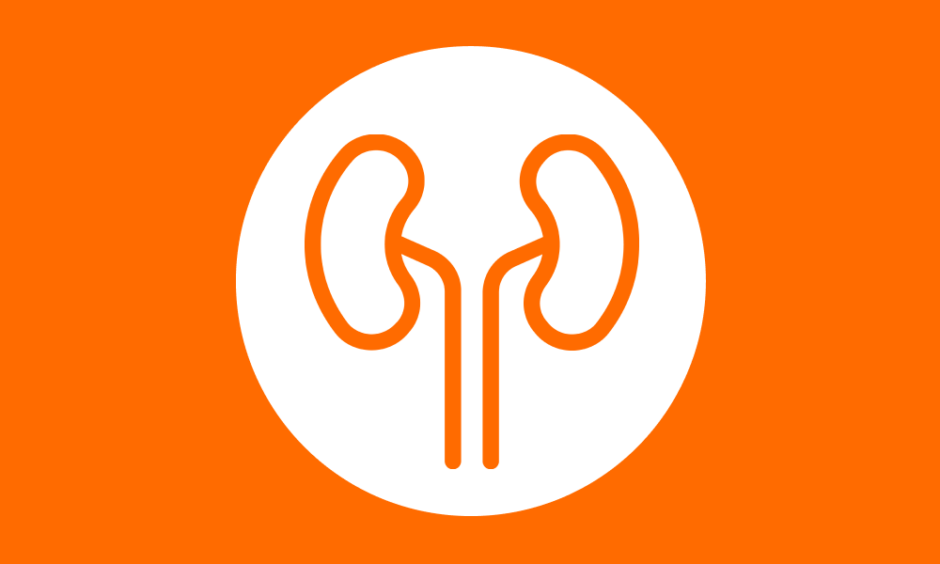Abstract
Antegrade conversion to nephroureteral stent is common after percutaneous nephrostomy tube placement for obstruction when retrograde alternatives fail. Nephroureteral stents often have a nylon retaining suture attached to aid in placement and removal. If the nephroureteral suture is not removed, it can become embedded in the renal parenchyma as nylon is unabsorbable, preventing stent removal and potentially leading to adverse outcomes. This case report describes a complication of antegrade nephroureteral stenting and shows that retrograde ureteroscopy with holmium lasering of the retained suture was an effective treatment for the removal of retained stents. Furthermore, after a difficult extraction of the nephroureteral stent, the patient displayed minimal post-operative sequelae, and no visible defects on follow-up renoscopy.
Key Points
1. When retrograde alternatives fail following percutaneous nephrostomy tube placement for obstruction, it is common practice to use a nephroureteral stent. However, this poses potential problems, including prevention of removal of the stent if the attached non-absorbable nylon suture is not removed, with possible adverse sequelae.2. Prior to this case study, no literature existed on the rare phenomenon of stent suture tethering to the renal parenchyma and how this prevents removal.
3. In this case, retrograde ureteroscopy with holmium laser on the retained suture proved an effective treatment in the removal of the stent.
INTRODUCTION
Ureteral obstruction can be caused by malignancy, urolithiasis, external compression, congenital defects, and iatrogenic injuries.1 Subsequent hydronephrosis secondary to obstruction is often decompressed by antegrade or retrograde access.2 Retrograde access is often performed via cystoscopy with the placement of a nephroureteral stent, whereas antegrade access is typically performed with a percutaneous nephrostomy catheter, percutaneous nephroureteral tube, or percutaneous antegrade ureteral stent.3 The interventions are performed under fluoroscopy to ensure correct positioning. Ureteral stents are associated with multiple complications including stent migration, urinary tract infection (UTI), encrustation, and occlusion.4 Increased stent indwelling time, typically longer than 6 weeks, is one factor responsible for multiple of these aforementioned complications.5
Nephroureteral stents are often manufactured with a permanent suture at the distal end to facilitate placement and subsequent extraction of the stent.6 Previous studies have shown no change in complications such as UTI or post-operative morbidity in patients with existing ureteral stent extraction strings.7 Similarly, extraction strings have comparable rates of adverse events.8 However, no current literature exists to show that the stent suture can tether to the renal parenchyma to prevent removal. This article presents a case of a patient with a retained suture in the renal papilla from antegrade ureteric stent placement, with the objective of demonstrating that retained string may ultimately lead to tethering and other complications.
CASE PRESENTATION
A 95-year-old male with hypertension and end-stage renal disease on haemodialysis (HD) for 7 months initially presented for bilateral nephroureteral stent removal. The patient had a history of congenital, bilateral ureteropelvic junction obstructions, first diagnosed 6 years prior to initial presentation. The ureteropelvic junction obstructions were managed with bilateral nephroureteral stents in an effort to maintain his kidney function. The patient was currently being treated for a UTI with urine cultures positive for Enterococcus and Pseudomonas. He had undergone multiple routine nephroureteral stent exchanges prior to initiating HD; however, once starting HD, the removed left nephroureteral stent was unable to be replaced due to loss of retrograde access intraoperatively. Therefore, interventional radiology placed a left percutaneous nephrostomy catheter, which was internalised to an 8 Fr, 26 cm double-J stent 3 days later (Figure 1). The patient was ultimately discharged post-nephroureteral stent insertion.
The patient presented to the hospital 7 months later for bilateral ureteric stent removal due to minimal urine production on HD and concerns for potential nidus for infection with indwelling stents. The patient was ultimately taken to the operating room for stent removal. Intraoperative plain radiography and fluoroscopy confirmed no malpositioning or encrustation of bilateral stents.
The right ureteric stent was successfully removed with flexible graspers. However, when attempting to remove the left stent, the stent was seemingly fixed in position at the proximal portion. The distal end was mobilised to the meatus and a guidewire was then used to attempt to straighten the stent to aid in movement, but it did not change position despite no retaining curl seen. A retrograde ureteroscopy, performed with a 7.4 Fr flexible ureteroscope with a 3.6 Fr working channel, alongside the stent showed a blue suture preventing the stent from being removed. A 200 micron holmium laser fibre (SlimLine™, Boston Scientific, Massachusetts, USA) was required to cut the proximal part of the suture and allow the stent to be extracted. Renoscopy was then performed and identified a suture attached to a papilla in the lower pole, revealing the source of stent immobility. This suture was unable to be removed with ureteroscopic graspers as it was firmly embedded within the renal pelvic wall. The holmium laser was utilised again to cut directly on the papilla and remove pieces of the suture with the ureteroscopic graspers. The proximal remaining portion of the suture was left in the parenchyma since it was unable to be removed without damaging the parenchyma (Figure 2). Gross appearance of the suture can be seen in Figure 3.
A new left double-J stent nephroureteral stent was placed, as the patient elected to undergo double-J stent exchanges instead of definitive surgical therapy, such as pyeloplasty. On repeat renoscopy 3 weeks later, there were no defects seen in the renal papilla and the nephroureteral stent was removed. On a 10-month follow-up, the patient was continued on HD and has had no additional UTIs, flank pain, or repeat urologic interventions.
DISCUSSION
Nephroureteral stents are frequently used in patients with ureteral obstruction, obstructed pyelonephritis, and post-surgical treatment of urolithiasis.9 Manufacturers often produce the stents with a string attached, making these stents manageable to remove or reposition.10 These strings are made of fine suture material, commonly composed of nylon.11 Nylon is a nonabsorbable suture, which can lead to potential complications if not removed. Multiple studies have found no differences in quality of life or post-operative complications in patients with retained ureteral stent extraction strings.7,12 However, as the authors’ case has demonstrated, complications can arise with these extraction strings if left in situ. Additionally, hypercalcaemia is a common sequelae of end-stage renal disease and may have precipitated stent encrustation via dystrophic calcification, furthering risk for stent complications and difficult removal.13
There was no reported difficulty in placement, per the procedural note, and no skin defect. The incidence of this occurrence is unknown, and no known case reports have outlined the removal of retained suture within the kidney using a holmium laser. Other stent complications, including proximal stent knotting, have been successfully treated with holmium laser ablation.14,15 In both cases, the laser was used to transect the proximal knot, resulting in detachment. In this case, the suture was unable to be pulled with graspers, but laser ablation on dusting settings appeared to remove nearly all components in the collecting system despite leaving behind a short segment in the renal parenchyma. Current literature defines optimal dusting settings for retrograde ureteroscopy when using a 120 watt holmium laser (Lumenis®, Pulse™, Boston Scientific, Massachusetts, USA) in the renal collecting system as 0.2 to 0.3×70; JxHz.16
Foreign bodies can become a nidus for stones, fistulas, and infection;17 at 10-month follow-up post-stent removal, the patient had an uncomplicated recovery with stable follow-up. There was no defect seen on repeat renoscopy and, since there is an increased rate of complications with retained suture in the renal parenchyma, imaging will be performed annually, or earlier if the patient becomes symptomatic. Attempted removal of defective ureteral stents without proper caution and management carries a risk of injury. Failure to remove the permanent suture on the nephroureteral stent prior to deployment can cause stent retainment. This case shows that a holmium laser can be an effective method to incise the suture.
CONCLUSION
Retained suture from an antegrade ureteric stent appears to be a rare phenomenon preventing cystoscopic stent removal. Given the case, the authors recommend caution when using a suture-dwelling stent during an antegrade approach. Retrograde ureteroscopy with holmium lasering of the retained suture appears safe for stent removal with tethering suture in the renal parenchyma and can avoid injury to the collecting system.








